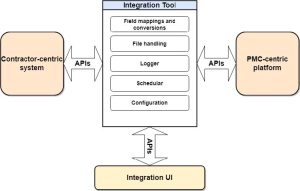It would be impossible to think of any large EPC project management solutions without any need for 3rd party integrations. Invariably for every sizable EPC project management solution, a robust integration approach becomes paramount for achieving operational efficiency.
This blog discusses the intricacies of a comprehensive data integration system designed to foster seamless collaboration among EPC project stakeholders, from contractors to upper management.
Setting the Stage: A Unified Data Approach
While working on a large EPC management system, in the project ecosystem, a system has emerged as the go-to platform for consolidating data across diverse sub-projects in that large EPC project. The objective is to present this consolidated data in a standardized format tailored for the scrutiny of upper management.
At core of this eco-system stands a Project Management and Consulting (PMC) firm focusing on project oversight. This PMC entity is entrusted with the responsibility of reporting project statuses to the end organization. The reporting follows a standardized format termed the “Master Copy.” The overall project is a collaboration across various projects done by various contractors, each handling individual responsibility.
To facilitate streamlined data exchange, contractors utilize a specialized system for their individual data submissions. These systems, both the one employed by the PMC and the contractors, boast published APIs that play a pivotal role in the integration process.
Modules Under the Integration Umbrella
The integration effort spans across various critical modules crucial to project management. These include modules, for example, Insurance, Bank Guarantee (BG), Documents, Cash-flow (Payments) etc. Each module carries its own significance in the broader picture of project execution and management.
Navigating the Integration Landscape: High-Level Architecture & Data Flow
A key component in this seamless collaboration is an integration tool strategically positioned between the contractor-centric systems and the PMC-centric platform. This integration tool serves as a conduit, ensuring the smooth flow of data from the contractor systems to the PMC platform for various modules and projects.
In the case of a few modules like Documents, the contractor system provides an API to update Submittal status. The PMC platform then calls this API whenever changes in status occur. An additional layer of complexity involves the need for the integration tool to map unique identifiers between the two systems, facilitating accurate updates associated with specific documents.
Interestingly, there are instances where data, especially status of Documents, originates in the PMC platform and is pushed to the contractor system. In such scenarios, the integration tool takes updates from the PMC platform and sends them to the contractor system.

Key Observations and Considerations
- Unidirectional Data Flow: The predominant data exchange direction is from the contractor-centric systems to the PMC platform.
- Status Feedback: Noteworthy is the existence of modules like Documents where status information flows back from the PMC platform to the contractor system.
- Nuanced Data Flow and Mapping: This involves typical flow and data mapping intricacies within this integration framework.
- Incremental updates: So that the integration tool shall not process all the data every time it runs. It has been designed in such a way that it processes only records which were not processed before.
- Maintaining logs: For scrutinizing errors encountered, detailed logs have been maintained. These logs can be viewed via a dedicated portal for the integration tool.
- Triggering integration: These integration scripts could have been triggered automatically by a scheduler or manually via the integration portal.
In essence, this integrated approach paves the way for a cohesive project management experience, ensuring that data moves seamlessly across various stakeholders, modules, and projects. This data integration contributes to enhanced visibility, efficiency, and collaboration in overall project execution.
In the last five years, we at CoReCo Technologies, have worked with 60+ businesses of various sizes, from various industries, from across the globe. We have helped product owners get answers to these two important questions, and also developed products and platforms for them.
This collaboration has helped our customers to get clarity about product strategy, and finally resulted in generating good revenues or attracting significant funding from investors. Sometimes this discussion encouraged them to go back to the drawing board, rethink the strategy, and come back stronger, resulting in a big saving of effort, time, and money.
For more details about such case studies, do visit us at www.corecotechnologies.com and to convert this virtual conversation into a real collaboration, please write to [email protected].
Atul Patil
Senior Principal Software Engineer
CoReCo Technologies Private Limited



